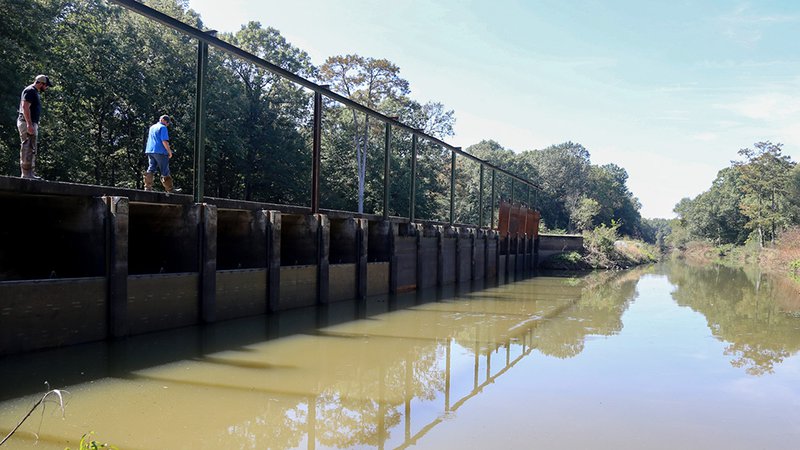Target infrastructure operation dates for popular duck-hunting areas set for 2017-18 season
ON 08-09-2017

Aug. 9, 2017
Randy Zellers
Assistant Chief of Communications
Biologists with the Arkansas Game and Fish Commission have developed later target dates for managing water control infrastructure on greentree reservoirs the AGFC manages. Operation of water control structures will not begin on most areas until Nov. 15, 2017, in an attempt to mimic natural historic flooding timing more closely than previous management.
The change is intended to protect beneficial red oak species within the systems while still offering duck hunters the opportunity to enjoy hunting Arkansas’s famous flooded timber.
Consistent flooding during the growing season changes the make-up of bottomland hardwood stands, replacing willow oak and Nuttall oak with more flood-tolerant species such as overcup oak and elm, which are of much less benefit to ducks using the area.
Historically, in an attempt to offer more reliable habitat for waterfowl and hunters, the AGFC developed greentree reservoirs to flood hardwood areas during winter, when trees are dormant, while leaving them dry during the growing season, when they are vulnerable. Over time, however, annual infrastructure operation dates tied to opening day of duck season have resulted in more consistent early fall flooding before trees are dormant, resulting in damage to valuable red oak forests.
“The red oaks are being replaced by less desirable species,” said Jason Jackson, wetlands biologist for the AGFC. “But it’s happening slowly, and many hunters don’t recognize the change.”
Jackson says historic flooding cycles ebbed and flowed and were much later in the year. This allowed the red oak species to become established as part of the forest.
“You don’t want water on the trees at a constant level, and you don’t want the trees to see constantly flooded conditions before they go dormant,” said Jackson.
Dates placed in previous water-management plans for WMAs lean toward having these artificially flooded areas at full pool near opening day of duck season.
“You can look up and see the green leaves still on the trees well into November and December in parts of Arkansas,” Jackson said. “It’s pretty easy to see the trees aren’t dormant on Oct. 15, when we’ve traditionally begun closing water control structures on many WMAs.”
Luke Naylor, waterfowl program coordinator for the AGFC, says the November dates set this year are only a first step in the process of changing how these critical wetlands are managed.
“We are working on developing more data-driven criteria to begin infrastructure operation when the trees are dormant,” Naylor said. “It may include soil temperatures, visible indicators of tree dormancy, and other factors. Ideally, I would rather not have any calendar dates involved and work within adaptive management plans to flood these areas when they are the most benefit to ducks and can sustain their benefits for generations to come.”
The delay in intentional flooding is the second on-the-ground effort toward reversing damage to beneficial red oaks in greentree reservoirs created for waterfowl habitat.
“Last year, we delayed the intentional flooding of Henry Gray Hurricane Lake WMA because of the extensive amount of water the GTRs have seen throughout the year during the last few years,” Naylor said. “This year, the GTR again has been underwater for months during spring and summer, so we hope that short break we gave the trees helped reduce the stress a little.”
The amount of time many waterfowl areas are being flooded in spring and summer has been a concern among many hunters who attended meetings concerning the proposed changes to the AGFC’s water-management plans. Unusually wet conditions during late spring and early summer, as well as some changes in water use upstream of popular GTRs, have kept standing water in the woods longer than usual. Naylor says biologists have these concerns as well, and they are looking at ways to improve those conditions for the long-term.
“We are evaluating conditions on each of our GTRs, and are looking at long-term solutions to prevent more damage to the beneficial oaks in the system while encouraging the next red oak forest to grow,” Naylor said. “In many cases, it will take major modifications to the infrastructure to help. But we need to focus on what we can control in the short-term to give the trees relief from flooding stress until those modifications can be made.”
Visit www.agfc.com/gtr for a list of proposed flooding dates on AGFC-managed greentree reservoirs.
Recent News

Baiting wildlife illegal on Lake Conway
Nov. 22, 2024
Subscribe to Our Weekly Newsletter E-mails
Don’t miss another issue. Sign up now to receive the AGFC Wildlife Weekly Newsletter in your mailbox every Wednesday afternoon (Waterfowl Reports are published weekly during waterfowl season and periodically outside the season). Fishing Reports arrive on Thursdays. Fill in the following fields and hit submit. Thanks, and welcome!

